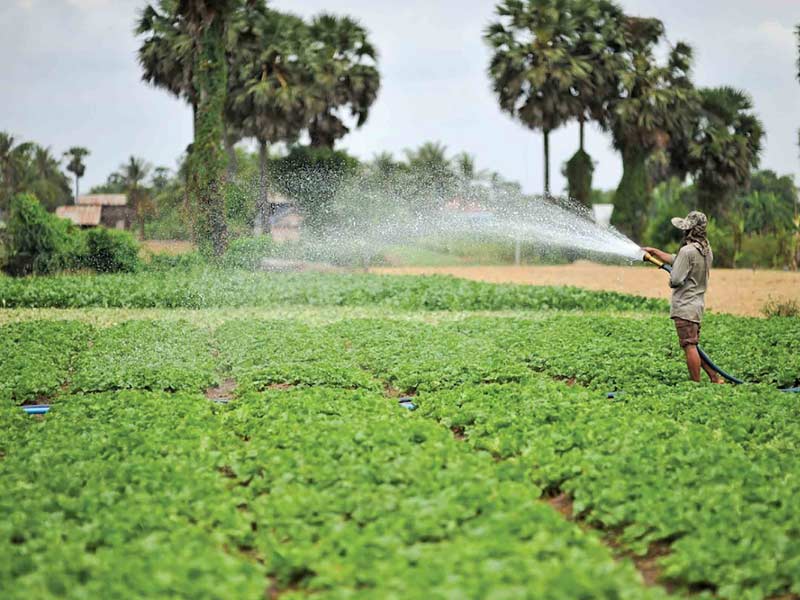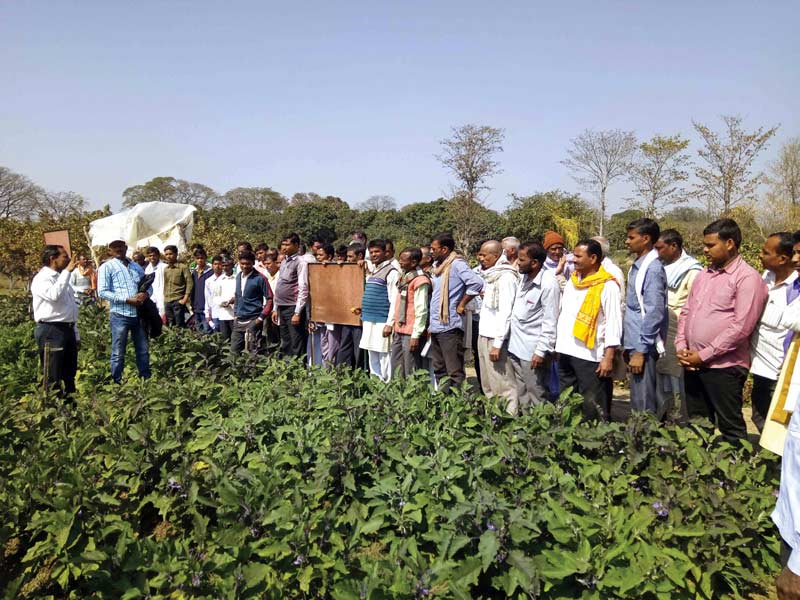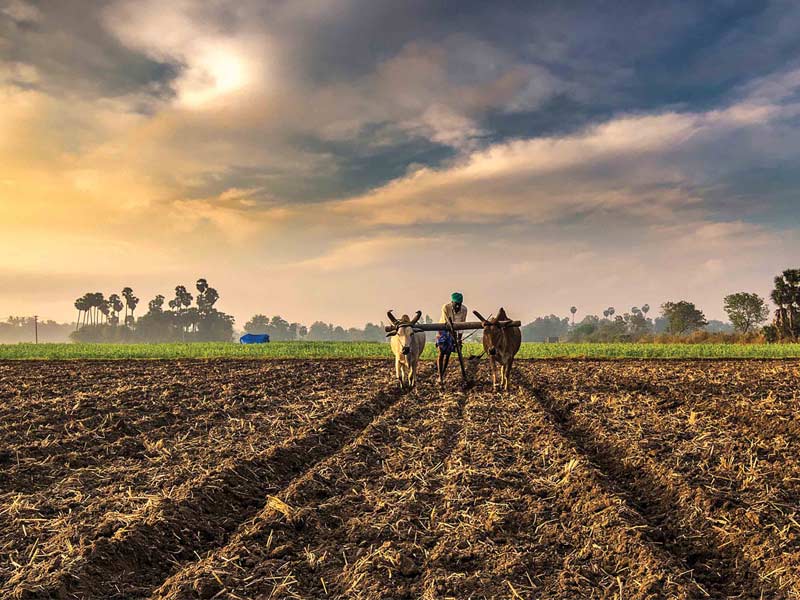IN India, foodgrain production has largely been possible through irrigated agriculture. But over 50 per cent of cultivated land that produces more than 80 per cent of nutri-cereals, pulses, oilseeds, fruits and vegetables is monsoon dependent. Such land in ‘rainfed’ regions also face vagaries of aberrant monsoons, droughts, soil degradation, nutrient deficiencies and declining ground water table. We are a food secure nation notwithstanding. Ensuring nutritional security and climate change resilience are additional future concerns.

There is a mammoth need, in the above context, of empowering small and marginal farmers, especially women, in rainfed areas by increasing their access to quality extension and advisory services. Access of such farmers to modern input practices, new technologies and output markets, experts opine would enable them to effectively respond to vagaries mentioned above. This would also, they add, enable achieving the target of doubling farmers’ income by 2022.
The Report on the Committee of Doubling Farmers Income (DFI) aptly defines agricultural extension as a system of sharing of information, knowledge, technology and skills so as to enable farmers to realize higher net income from their enterprise on a sustainable basis.
An important arm in the country’s public extension and advisory services is the National Agricultural Research System (NARS) that includes as many as 113 research centers/institutes of Indian Council of Agricultural Research (ICAR), 77 State Agricultural Universities (SAU)/ Central Agricultural Universities, Water and Land Management Institutes (WALMI) and Commodity Boards (Coffee, Tea, Spices, Tobacco, Silk, and Coconut). The above is supplemented with 700 Krishi Vigyan Kendra’s located in districts for ascertaining local adaptability of technologies through outreach to farmers.
Besides, the Agricultural Technology Management Agency (ATMA) is a multi-agency platform in each state that operationalises the strategic research action plan through a participatory approach. The action plan envisages capacity building and training of farmers through individual and group contact on agricultural production activities/ technologies including allied activities such as dairying, livestock and fisheries. ATMA also plays a key role in giving wide publicity to Agri-Clinic and Agri-Business Centers (AC&ABC) in districts to assist potential agri preneurs. Technologies include practices such as zero tillage, raised bed planting, direct seeded rice, crop residue seeders; laser leveling, micro irrigation, seed/fodder banks.
In addition, the National Institute of Agricultural Extension (MANAGE) is an autonomous body under the Ministry of Agriculture and Farmers Welfare that is mandated to assist state and central governments in dissemination of agricultural knowledge and policy advocacy. NARS, KVKs, ATMA and MANAGE function at the community block level in tandem with the Panchayati Raj Institutions (PRIs)/Common Service Centers (CSCs) in states through a huge workforce of agricultural scientists and qualified extension functionaries.
TWO key strategies that form the core of extension activities include “on farm trials” and “frontline demonstrations” to identify location specific technologies and their applicability in crop or animal husbandry. These strategies also subsume the last mile analysis of the information needs of farmers for an agricultural cycle ranging from pre-planting, seeding, preparing/ planting, growing, harvesting/ post-production/ packing, storage to marketing stages. The aim is to mitigate issues such as high yield gaps, low seed and varietal replacement rate, poor crop nutrient management and use of low-quality agricultural inputs. Such issues arise essentially due to lack of information, awareness and sensitisation. A key element is also assessing the level of absorption of information or technology and the consequent behavioral change achieved amongst farmers in diverse agro climatic zones.

A critical issue, experts state, is the strengthening of the ATMA-KVK linkage through public private partnerships at the Block level. Such partnership is to be fostered to create extensive awareness about the benefits of farm incubation to innovate and post-harvest management / marketing with end-to-end solutions. Another issue is deeper engagement with small and marginal farmers regarding benefits of being a part of the new age collectives such as Farmers Producer Organizations (FPOs) in the form of either cooperatives, companies or societies. A third critical issue is leveraging extension and advisory services for small and marginal farmers especially in rainfed areas through print / electronic / community radio / social media and Information & Communication Technology (ICT) enabled value system knowledge platform.

In fact, “market led” extension and advisory services through ATMA-KVK linkage are necessitated increasingly due to launch of the flagship electronic National Agriculture Market (e-NAM) programme. This is a trade platform that aims at reducing market intermediaries and promoting value addition to realise better farm gate prices. Similarly, the Government of India’s ICT initiates such as dissemination of crop advisories to farmers through “Kisan Suvidha” and “m-Kisan” portals with short messaging services aim to extend outreach across states. This is being supplemented with strengthening of precision data analytics to effectively analyse changes in agricultural cycles on account of climate change. Technologies deployed to do so include mobile imaging, drone patrolling, GPS / RIPD tracking, etc.
Market-led extension and advisory services through ATMA-KVK linkage are necessitated increasingly due to launch of the flagship electronic National Agriculture Market (e-NAM) programme. This is a trade platform that aims at reducing market intermediaries and promoting value addition to realise better farmgate prices
In the above backdrop, NASSCOM’s interesting study on emerging trends on “Agritech in India in 2019” highlights the evolution of approximately 450 agriculture start-ups with an investment of USD 248 million. Key areas of operation by these Startups for farmers empowerment include expanding market linkages, real time access through agri-stacks and uberisation of inputs.

THE study illustrates the case, amongst many, of an organisation “Fasal” that uses an artificial intelligence platform to generate real time alerts about crop / weather conditions and issues advisories to small and marginal farmers in states of Karnataka, Chhattisgarh, Madhya Pradesh, Maharashtra and Andhra Pradesh. Besides, organisations such as Cropin, JivaBhumi, Agnext and Kisan Raja have created partnerships with the central and state governments in areas of sustainable livelihoods, FPO digitization, farm to factory traceability, quality estimation and saving water.
Companies such as Digital Green, EM3, Zamindara, Crop Connect, Agrihub, Galla Foods, Mapro Farms, FarMart, Tessol, Rinac and S4S have also deployed myriad strategies to benefit small and marginal farmers in post-harvest management/output marketing. These range from mechanisation leasing models, farmer training/capacity building, solar technologies, contractual agreements, digital platforms enlisting agricultural students/ rural youth and for FPO mobilisation.
It is the experience of such ventures in last mile extension and advisory services that the robust ATMA-KVK linkage has to factor in for widest dissemination of agricultural good practices/technologies to small and marginal farmers. Last but not the least, there is a need to delicately balance ICT-based extension and advisory services with face-to-face communication to ensure message reinforcement, be it through farm trials, demonstrations or community interactions.
(The author is a Joint Secretary in the Ministry of Agriculture and Farmers’ Welfare, Government of India. The views expressed are personal)


























































